通过海藻酸钠电解质-磺化氧化石墨烯生物膜增强质子电导率和降低甲醇渗透率
摘要
Nafion® 膜的高甲醇渗透率和高成本是直接甲醇燃料电池应用的主要挑战。为解决这些问题,一种以海藻酸钠(SA)聚合物为基体,磺化氧化石墨烯(SGO)为无机填料(0.02-0.2)的低甲醇渗透性和高质子传导性非Nafion聚合物电解质膜wt%) 是通过简单的溶液浇铸技术制备的。 SGO的-SO3H与海藻酸钠聚合物之间的强静电吸引力增加了机械稳定性,优化了吸水率,从而抑制了膜中的甲醇渗透。 SA/SGO 膜的最佳性能和性能由负载为 0.2 wt% SGO 的 SA/SGO 膜呈现,其质子电导率为 13.2 × 10 -3 Scm −1 ,甲醇渗透率为1.535 × 10 -7 厘米 2 s −1 在 25°C,远低于 Nafion (25.1 × 10 −7 厘米 2 s −1 ) 在 25°C。 SGO的加入提高了海藻酸钠聚合物的拉伸强度和断裂伸长率等力学性能。
背景
通过化学反应将燃料中的化学能简单地转化为电能只能通过燃料电池装置来完成。关于这种能力,直接甲醇燃料电池 (DMFC) 受到了极大的关注,因为它可以仅使用 17% 的甲醇作为燃料来发电,与其他方法相比,污染物排放更少,并且在飞行时也可以安全使用 [1] . DMFC 在许多应用中具有广泛的功能,例如医疗工具、助听器和便携式工具。遗憾的是,由于生产成本高(约 1000 美元 m −2 ) [2]、商业化膜 (Nafion) 的高甲醇渗透性以及当前电催化剂(钯和钌)的低反应性和低耐用性 [3]。质子电解质膜是 DMFC 中最重要的组成部分,因为它充当燃料和氧化剂的分离器,以及传导质子的路径;因此,它会对整个系统的效率产生重大影响。在所需的膜特性中,膜应具有高质子传导性和有效阻止甲醇穿过膜以避免阴极侧中毒的能力[4]。此外,确保使用无害、廉价的膜原材料也很重要。目前的商用膜(Nafion)不满足这些主要要求;因此,由于其高甲醇渗透性、高成本和使用危险材料,它不是 DMFC 应用的好膜。此外,其质子传导性受这些问题的影响,因此限制了其在 DMFC 应用中的有效性。目前,生物材料因其安全、环保而备受关注,被归类为绿色科技材料。作为一种新型的优良生物材料,海藻酸盐在组织工程、生物医学、药物输送载体、食品包装和 DMFC 等应用领域引起了许多研究人员的兴趣 [5]。海藻酸盐是在棕色海藻中发现的一种重要的水溶性多糖,它由 (1-4)-连接的 β-d-甘露糖醛酸 (M) 和 α-l-古洛糖醛酸 (G) 单元组成。它具有非常高的吸水率,可以吸收自身重量200-300倍的水[6]。由于缺乏连续的转移途径和聚合物的弱导电能力,原始海藻酸盐的质子传导能力较低 [6,7,8,9]。先前的研究表明,提高这种聚合物材料的机械性能和专门化其他性能的最有效方法是引入无机材料和聚合物主链 [7]。复合材料可以扩展或提供通过单独使用每个组件难以获得的新功能。例如,通过将碳纳米管和氧化石墨烯引入藻酸盐聚合物基质中,已成功提高了藻酸盐的机械强度 [3, 10, 11]。先前关于生物聚合物膜开发的研究表明,当与其他材料如无机或合成聚合物,例如双层壳聚糖(1.67 × 10 -6 厘米 2 s −1 ) [12], 壳聚糖-PVA/Nafion (2.2 × 10 −6 厘米 2 s −1 ) [13], 壳聚糖-SHNT (0.76 × 10 −2 Scm −1 ) [14], 壳聚糖-沸石 (2.58 × 10 −2 S cm −1 ) [15], 壳聚糖-PMA (1.5 × 10 −2 S cm −1 ) [16], 壳聚糖-海藻酸钠 (4.2 × 10 −2 S cm −1 ) [17], 藻酸盐-角叉菜胶 (3.16 × 10 −2 S cm −1 ) [18], 磺化壳聚糖-SGO (72 × 10 −2 S cm −1 ) [19], PVA-海藻酸钠 (9.1 × 10 −2 S cm −1 ) [20], 生物纤维素-Nafion (7.1 × 10 −2 S cm −1 ) [21], 壳聚糖-SPSF (4.6 × 10 −2 S cm −1 ) [22], 壳聚糖-二氧化硅/碳纳米管 (CNT) (2.5 × 10 −2 S cm −1 ), 壳聚糖-PVP (2.4 × 10 −2 S cm −1 ) [23], 纳米纤维素/聚吡咯 (1.6 mW cm −2 ) 对于酶燃料电池 [24],纤维素纳米纤维 (CNFs) (0.05 × 10 −3 S cm −1 ) 和纤维素纳米晶体 (CNCs) (4.6 × 10 −3 S cm −1 ) [25],细菌纤维素 (BC)/聚(4-苯乙烯磺酸)(PSSA)(0.2 S cm −1 ) [26], 和咪唑掺杂的纳米晶纤维素 (2.79 × 10 −2 S cm −1 ) [27]。然而,与涉及包括燃料电池在内的许多领域的合成聚合物的研究相比,开发的基于生物聚合物的膜的数量太少。此外,不可否认,壳聚糖比其他碳水化合物聚合物更受关注。
氧化石墨烯是一种很有前途的碳基材料,在许多应用中具有很高的潜力,包括电子、纳米复合材料、生物医学和燃料电池。氧化石墨烯具有优异的性能,如高纵横比、高导电性、高机械强度、独特的石墨化平面结构和电绝缘性能[28]。作为亲水聚合物基体中的添加剂材料,它提供高弹性以抵抗因水分引起的膨胀。此外,由于其成本低得多,氧化石墨烯比 CNT 更可取,这使其成为 DMFC 应用中膜的最合适候选者 [29]。先前的研究表明,GO 增强了天然聚合物,如壳聚糖薄膜和壳聚糖-明胶多孔整料 [19, 30]。拜耳等。 [31] 制备了一张 GO 纸,其氢渗透率比 Nafion 低三倍,质子电导率为 49.9 mScm -1 使用面内技术。 Lue 等人的直接液体燃料电池 (DLFC) 性能非常好。 [32] 将 GO 引入 Nafion。然而,GO 作为质子导体的性能是有限的,因为它缺乏可以作为膜中质子载体的官能团,这会对质子电导率产生不利影响并降低燃料电池性能 [19]。卡里姆等人。 [33] 报道他们研究中 GO 纳米片的电导率为 15 mS cm −1 以及 Hatakeyama 等人报告的 GO 电导率。 [34] 和拜耳等人。 [35] 为 0.4 mScm −1 和 0.55 mScm −1 , 分别。基于这些弱点,磺化 GO 被认为是该应用中比 GO 更好的选择,因为磺化 GO 显示出更高的质子传导性,并且由于 GOS 和 SO3H 之间的高度相容性,它促进了均匀膜的形成 [19]。基思等人。 [36] 发表了一篇 SGO 论文,该论文显示了 113 mWcm −2 的高最大功率密度 对于聚合物电解质膜燃料电池 (PEMFC),电压为 0.39 V。 -SO3H 掺入的优点如下:(i)酸基团可以为质子运动提供补充跳跃位点,以及(ii)静电吸引力将通过干扰藻酸盐链的流动性和堆积来提高热稳定性和机械稳定性。根据我们的研究,尚未使用这种方法生产纳米复合藻酸盐/SGO 材料。在电气设备应用中使用生物材料将导致生物科学和可持续能源技术之间的跨学科研究。因此,本研究将结合海藻酸盐和 SGO 的优点,形成一种具有高耐久性、良好的质子传导性和甲醇渗透性的新型生物膜,其目标是其性能优于 Nafion 或其他商业质子交换膜 (PEM),如并且生产成本比 Nafion 便宜得多。
方法
材料
TIMREX PG25天然石墨购自TIMCAL Ltd. 浓硫酸(H2SO4, 95%)、甲醇(CH3OH, 99.7%)、高锰酸钾、盐酸、双氧水水溶液(H2O2, 35%)、氯化钙、乙醇、磺胺酸、亚硝酸钠溶液和甘油购自 Sigma Aldrich。这些化学品按原样使用,无需进一步纯化。所有实验均使用通过 Millipore 系统 (Milli-Q) 的去离子 (DI) 水。
膜准备
Hummer 的方法经过修改和应用,以提供天然石墨的 GOS [10, 37]。首先,在 500 毫升烧瓶中将 2 克石墨与 150 毫升 H2SO4(95%)混合。将混合物在冰浴中搅拌 30 分钟。在连续剧烈搅拌下,向混合物中加入 15 克高锰酸钾。小心控制添加速率以将反应温度保持在 20°C。然后将混合物搅拌并在室温下放置过夜,然后在剧烈搅拌下加入 180ml 水并在 98°C 下回流 24 小时;这导致溶液变成黄色。将 80 毫升 35% H 2 O 2 加入到反应混合物中,使其冷却至室温以便用 KMnO 4 淬灭反应。通过用 5% HCl 冲洗然后离心来洗涤所得 GO。最后,产物用去离子水冲洗数次,过滤并真空干燥。
在 70°C 下将 50 毫升氧化石墨烯添加到 8 毫升 0.06 M 磺胺酸溶液中。在持续搅拌下,将 2 ml 亚硝酸钠溶液滴加到混合物中,并在 70°C 的恒温下静置 12 小时。反应完成后,洗涤混合物并通过离心收集。将收集的 SGO 再用水洗涤数次直至达到 pH 7。SGO 颗粒通过 X 射线光电子能谱 (XPS) 进行表征。海藻酸钠溶解在 1% (w /v ) 双蒸水得到藻酸盐溶液。添加到藻酸盐溶液中的 SGO 含量各不相同,其值为 0.02、0.05、0.09、0.13、0.17 和 0.2wt%,以产生复合膜。用磁力搅拌器将混合物连续搅拌 60 分钟。将异质溶液转移到玻璃基板上并在 60°C 下放置 72 小时以进行薄膜形成过程。然后使用氯化钙/甘油溶液交联干燥的藻酸盐/磺化氧化石墨烯膜以增加机械强度并降低藻酸盐的亲水性。将膜浸入 100 毫升阳离子浓度保持在 1.5% w 的交联溶液中 30 分钟 /v .最后,通过用去离子水洗涤从膜表面去除任何游离阳离子,并将膜在 25°C 下干燥。制备方法总结在方案1中。
<图片>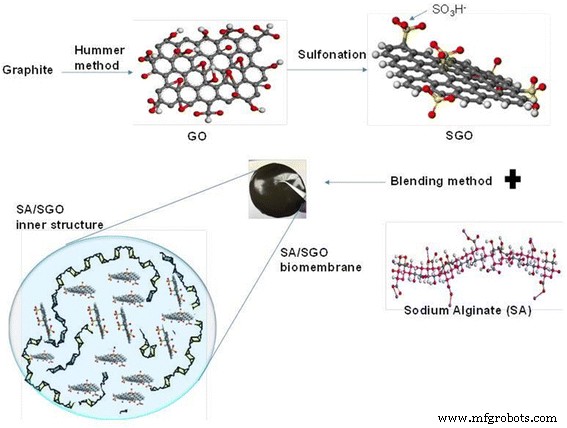
磺化氧化石墨烯(SGO)填料及SA/SGO生物膜制备方法
膜表征
分析了氧化石墨烯、磺化氧化石墨烯和膜的傅立叶变换红外 (FTIR PERKIN ELMER) 光谱。 FTIR 波长范围为 4000-500 cm -1 .使用场发射扫描电子显微镜(FEI QUANTA 400 FESEM)检查膜的微观结构,操作电压为 5 kV,作为基于生物材料的样品的预防措施。高分辨率透射电子显微镜 (HRTEM) 分析使用 o Digital TEM HT7700 在 300 kV 的加速电位下运行。
在带有花边碳支撑膜的网格上制备样品。 XPS 用于使用 Axis Ultra DLD 确定样品表面的化学成分。 SA/SGO 膜的机械强度用万能试验机测试,包括拉伸强度、杨氏模量和断裂伸长率。在室温下使用的载荷为 3 kN。湿膜和干膜的重量和长度(或厚度)的变化可以决定膜的吸水率和溶胀率。通常,将膜在 30°C 的水中浸泡 2 天。对于湿膜,记录重量和长度,然后除去膜中的水和膜表面的液滴。此外,湿膜在真空压力和 120°C 的温度下干燥至少 24 小时。还记录了干燥状态下膜的重量和长度。使用方程1和2,可以确定吸水量(WU%)和膨胀率(SW%),其中L 湿代表湿质量和L dry 分别表示由湿膜和干膜长度得到的干质量。
$$ \mathrm{WU}\%=\frac{{\mathrm{mass}}_{\mathrm{wet}}-{\mathrm{mass}}_{\mathrm{dry}}}{{\mathrm{质量}}_{\mathrm{干}}}\times 100 $$ (1) $$ \mathrm{SW}\%=\frac{L_{\mathrm{wet}}-{L}_{\mathrm{干}}}{L_{\mathrm{干}}}\times 100 $$ (2)甲醇吸收计算与水吸收计算相同,只是浸渍溶液改为甲醇而不是去离子水。
使用连接到恒电位仪/恒电流仪 (WonATech) 的四电极电导率电池计算制备的膜的质子电导率,该电导率在 1 MHz 至 50 Hz 的频率范围内运行。膜(1 cm × 4 cm 大小)必须在水中浸泡 24 小时才能在完全水合状态下获得电导率读数。运行恒电位仪以获得电压与电流的关系图。直线的梯度就是膜电阻。方案 1 展示了质子电导率测试的电池。质子电导率可以使用以下公式计算:
$$ \sigma =\frac{L}{RWT} $$ (3)其中 L 是两个电极之间的距离,W 是膜的宽度,T 是膜厚,R 是膜的电阻,类似于以前工作中的方法[38, 39]。
具有 20 v 的两个罐液体渗透性细胞 /v %甲醇用于确定膜的甲醇渗透率。甲醇浓度的差异导致甲醇穿过膜,并且可以确定甲醇渗透率。用公式3计算甲醇的渗透率:
$$ P=\frac{1}{Ca}\left(\frac{\Delta Cb(t)}{\Delta t}\right)\left(\frac{LVb}{A}\right) $$ ( 4)其中 P 是甲醇的膜扩散渗透率 (cm 2 s −1 ),Ca 是进料室中的甲醇浓度,即细胞 A (mol L -1 ), ∆Cb (t )/Δt 是细胞 B 中甲醇摩尔浓度随时间的变化 (mol L −1 s), V b 是每个扩散池的体积 (cm 3 ), A 是膜面积,L 为膜厚(cm)。
膜特性可以通过计算膜的选择性来确定,这可以通过高质子传导率和低甲醇渗透率来实现。用于计算选择性的公式如下:
$$ \varphi =\frac{\sigma}{P} $$ (5)其中 φ 代表选择性,σ 代表离子电导率,P 代表甲醇渗透率。
结果与讨论
磺化氧化石墨烯 (SGO) 和 SA/SGO 生物膜的表征
图 1a、b 中的 FTIR 光谱显示了 GO 和 SGO 之间的差异,可以清楚地观察到。图 1b 是图 1a 的放大图,以获得更清晰的 SGO 光谱峰视图。 SGO 的光谱在 1244 cm −1 处显示了一个新带 ,这是磺酸基团 (-SO3H) 的典型吸光度,而 GO 光谱不包含该带 [40]。此外,光谱在 1012、1036 和 1125 cm -1 波长处显示出新的峰值 , 被认为是 SO3H − 的对称和非对称伸缩振动 组。这个新的光谱表明,使用上述简单的方法,氧化石墨烯溶液成功地改性为磺化氧化石墨烯。同时,磺化修饰仍然保留了GO中的羟基等官能团在3319 cm -1 和 1636 cm −1 处的羧基 .进一步确认 SO3H − 的存在 可以通过XPS分析确定组。
<图片>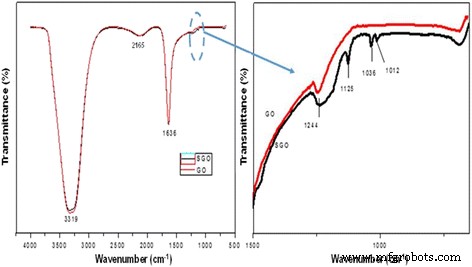
一 , b 氧化石墨烯 (GO) 和磺化氧化石墨烯 (SGO) 的 FTIR 光谱
图 2 显示了 GO 和 SGO 膜的 XPS 光谱,其中扫描光谱在 0-800 eV 范围内,以通过可测量分析识别现有元素的表面。可以观察到,在 GO 和 SGO 光谱中,C1s 和 O1s 信号分别出现在 286 和 531 eV。还注意到在将磺酸基团引入 GO 后,在 168 eV 处出现了一个新的 S2p 峰。与 GO 相比,SGO 中的磺酸基导致 O1s 光谱的强度略有增加。 C1s 的高分辨率光谱,被称为高斯光谱解卷积,证实了通过化学修饰成功定制了 GO [41]。图 2b 中的图是功能化 GO 在更大放大倍数下的 S2p 光谱。磺酸基团的结合能有助于在 168 eV 处出现 S2p 峰,该峰证实磺酸基团成功连接到 GO 纳米片骨架 [41, 42]。
<图片>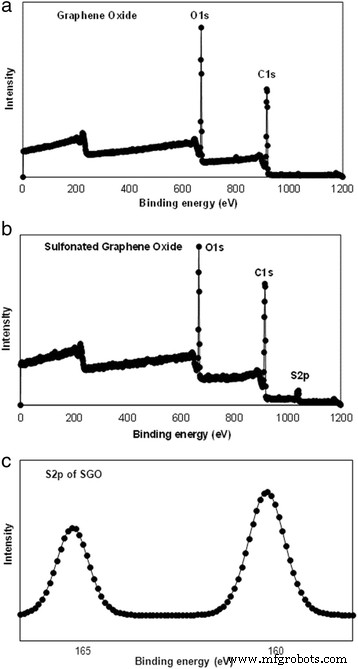
a 的 XPS , b 广谱 GO 和 SGO 和 c SGO的S2p光谱
如 FESEM 图像(图 3a)所示,片状 GO 形态证实了通过 Hummer 方法成功生产 GO。白等人。 [43] 也用 Hummer 的方法生成了 GO。他们的研究结果表明,GO和RGO的形态均出现轻微折叠并形成一些皱纹,与本研究中的GO形态相似。
<图片>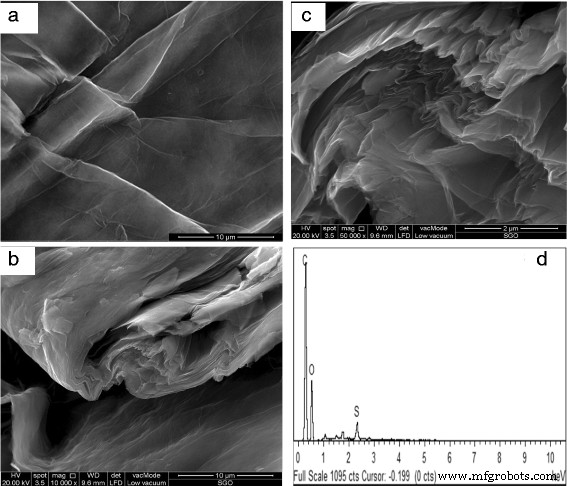
一 GO 的 FESEM 图像。 b , c 不同放大倍数和 d 下 SGO 的 FESEM 图像 SGO的EDX
图 3b、c 中 SGO 的 FESEM 图像与 GO 表面相比具有皱缩和粗糙的表面,这很可能是由于磺化过程的影响,证实了改性方法也已成功应用 [41, 44 ]。这与 FTIR 透射光谱中新峰的存在有关,该峰属于磺基。此外,通过 XPS 分析也证实了 GO 片中存在磺酸基团。 SGO 与 GO 不同,GO 具有多层结构,没有任何聚集。应用的改性方法导致形成分层和重新堆叠的结构;因此,SGO 展示了它的灵活性。能量色散 X 射线 (EDX) 结果表明 SGO 片中存在 1.76 wt% 的硫元素(图 3d)。
SA 和 SA/SGO 生物膜的表面图像和横截面如图 4 所示。图 4a-c 是表面图像,图 4d-f 是具有不同 SGO 含量的膜的横截面图像。低放大倍数和高放大倍数都表明 SGO 片完全均匀地分散在整个聚合物基质中,并受分子间相互作用的引导;人们认识到,在 SGO 中的磺酸基团和 SA/SGO 膜中的极性基团(-O-,C =O)之间存在氢键 [45]。 SGO 被放置在聚合物基质中,起到阻挡甲醇分子的作用。 SA/SGO6 的图像在完全扩展到整个海藻酸钠聚合物基质时看起来更好。图 5 是所形成的复合材料的 TEM 图像,其中 SGO 纳米片良好地分布在海藻酸钠聚合物基质中。海藻酸钠存在于纳米球颗粒结构中,这与 Marrella 等人先前报道的研究相似。 [46].
<图片>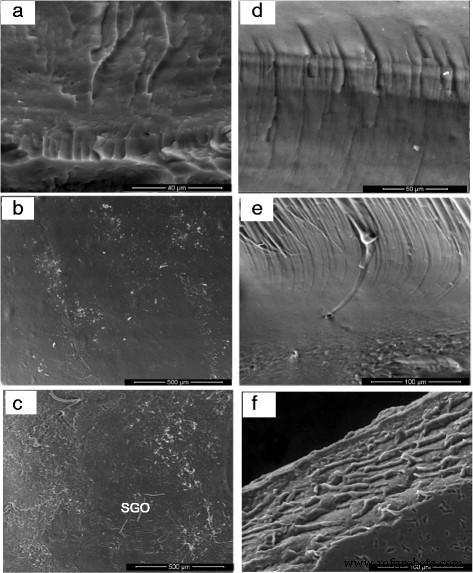
a 表面形貌和横截面的 FESEM 图像 , d 海藻酸钠,b , e SA/SGO4 和 c , f SA/SGO6生物膜
<图片>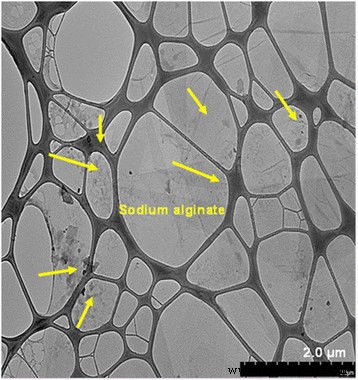
SGO纳米片分布在海藻酸钠聚合物基质中的TEM图像
FTIR 分析表明 SGO 和藻酸盐聚合物基质之间存在氢键相互作用。海藻酸盐和 SGO 海藻酸盐膜的 FTIR 结果如图 6 所示。根据氢键相互作用,氢键位点光谱似乎发生了轻微的变化。藻酸盐膜中的 O-H 基带出现在 1413 和 3440 cm -1 ;然而,波段转移到 1406 和 3404 cm -1 由于 SGO 中的极性基团和藻酸盐中的 O-H 基团之间的氢键作用,在 SA/SGO 膜中 [45]。藻酸盐膜中的 C=O 基团带也从 1082 cm −1 移动到 1046 .藻酸盐膜中磺酸基 (-SO3H) 带的位置也从 1284 变为 1277 cm -1 .因此,结果表明 SGO 和藻酸盐之间存在氢键 [47]。 SGO 颗粒在整个聚合物基质中的完全分散可以促进膜所有方向上的质子传导路径。结果表明,根据SEM内部结构和FTIR光谱,SA/SGO膜的性能优于原始海藻酸盐膜。
<图片>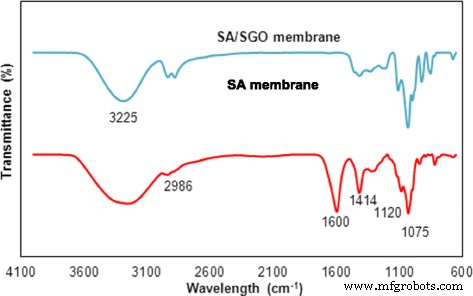
SA和SA/SGO膜的FTIR光谱
热稳定性和机械性能
图 7 显示了具有不同 SGO 含量的所有 SA/SGO 生物膜的 TGA 分析的比较。由于水分子的释放,第一阶段的损失发生在 200°C 以下,这被称为蒸发过程。通常,由于氧不稳定基团的分解,GO 的热分解温度约为 200°C,而对于藻酸盐聚合物,第一阶段的热分解温度为 178°C [48, 49]。 SA/SGO 生物膜在 198°C 的较高温度下显示出大量损失。这种升高的温度表明海藻酸钠和 SGO 之间存在相互作用,这增加了 SA/SGO 生物膜的耐热性。这表明,由于海藻酸钠基质和磺化氧化石墨烯纳米片之间的氢键或静电相互作用等有利的界面相互作用,SGO 的存在提高了生物膜的热稳定性,从而使该膜适用于 DMFC 应用。由于海藻酸钠侧链的分解,重量损失的第二阶段发生在 250°C 的温度下。第三阶段(> 400°C)涉及聚合物骨架的分解过程[50]。
<图片>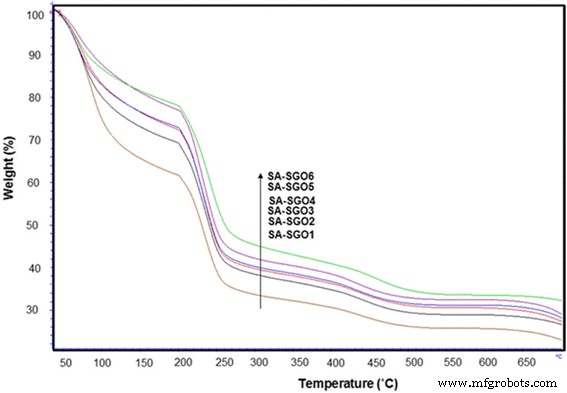
不同SGO wt%的SA/SGO生物膜的TGA曲线
图 8 显示了随着 SGO 的重量百分比变化,膜的拉伸应力和断裂伸长率。从 SGO 的 0.02 到 0.13 wt%,拉伸应力先增加,然后在 0.17 wt% 时略微下降。这可能归因于氧化石墨烯片的重新堆叠,这可能与 GO 纳米片中的范德华力有关。大量的氧化石墨烯纳米片导致滑动并降低氧化石墨烯在改善膜机械性能方面的作用。先前研究中 Nafion 和其他生物膜的拉伸应力列于表 1 [51,52,53,54,55]。与 SA/SGO6 生物膜相比,Nafion 膜具有更高的拉伸应力。但是,它在生物膜类别之间具有可比性。氧化石墨烯本身具有非常好的机械性能,弹性模量为1100GPa,固有强度为125GPa;这是SGO能够提高海藻酸盐膜力学性能的主要原因[45]。
<图片>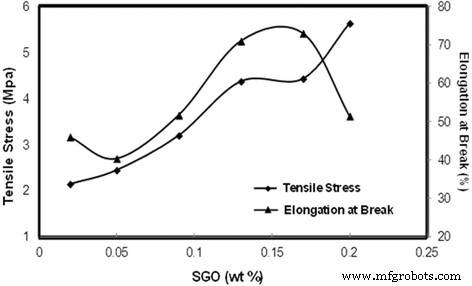
不同SGO wt%生物膜的拉伸应力和断裂伸长率
此外,SGO 与纯海藻酸盐基质聚合物之间形成的氢键也可以产生良好的机械性能。更多的氢键形成导致更强的界面粘附,从而提高膜的机械强度。断裂伸长率模式与拉伸应力模式相反。较低的拉伸应力导致较高的断裂伸长率。断裂伸长率表示膜可以拉伸到最大点的程度,也称为柔韧性。表 1 在断裂伸长率方面比较了先前研究中的几种膜与当前研究中的膜 [51,52,53,54,55,56]。拉伸应力和断裂伸长率之间的不同模式是合乎逻辑的。如上所述,膜中SGO的存在增加了由于氢键的界面连接,从而降低了膜的柔韧性。
吸液和膜溶胀率
众所周知,水是质子交换膜中的主要成分,因为它充当质子导体,其中吸附的水促进质子传输 [39]。图 9 显示了具有不同 SGO wt% 值的 SA/SGO 膜的水吸收和甲醇吸收结果。如图所示,与纯海藻酸盐相比,SA/SGO 膜具有较低的吸水能力,膜中磺化 GO 的含量不同(最低 WU - SA/SGO6 的 57.9%)。由于 SGO 作为膜中的填料具有阻塞能力,因此增加的 SGO 量会降低吸水率 [5]。 SGO的加入促进了离子通路的收缩,从而阻碍了水和甲醇的运动。 SGO 含量越高,膜的吸水屏障越强。 SGO填料和海藻酸钠聚合物之间的氢键增强了膜复合材料的界面粘附力,从而降低了吸水能力[19]。 SA/SGO 膜中的氢键形成涉及 GO 中的 –OH 基团、SA 链上的 –O- 和 C=O 基团,以及磺酸盐基团 (–SO3H) [3, 19] 的贡献。与吸水结果的模式类似,SA/SGO 膜的甲醇吸收也随着膜中 SGO 重量百分比的增加而降低。相同趋势的存在表明 SGO 和藻酸盐聚合物之间存在良好的网络和结合,这阻碍了燃料的穿越。从实验结果来看,基于氧化石墨烯的材料的存在降低了 SA 膜的吸水能力并保持了其机械强度。由于阻塞效应 [10],随着藻酸盐聚合物基质中 SGO 重量百分比的增加,溶胀率从 106% 下降到 61.12%(图 9)。 The strong hydrogen bonding also diminished the pathways for absorbance of the ionic group into the polymer [32].
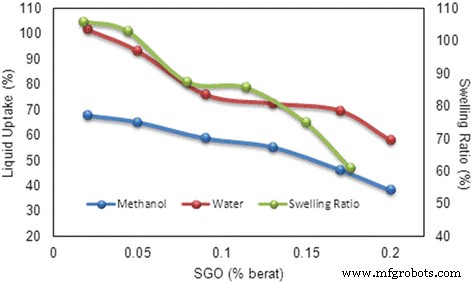
Liquid uptake and swelling ratio of SA/SGO membrane with wt.% of SGO
IEC, Proton Conductivity, Methanol Permeability, and Selectivity
Ion exchange capacity (IEC) calculation is important since it is responsible for measuring the number of milliequivalents ions in 1 g of the prepared membranes and is an indicator for proton conductivity in DMFCs.
Table 2 shows the IEC values of the membranes. A higher IEC value is achieved by the SA/SGO membrane containing a higher wt% of SGO. This is due to the function of sulfonic acid groups in the SGO nanosheets. An increment in the IEC value increases the proton conductivity value of the SA/SGO biomembrane. The proton conductivities of the SA/SGO membrane versus temperature are presented in Fig. 10. Increasing the temperature leads to the enhancement of proton conductivity. The SA/SGO membrane features a consistently increasing pattern in proton conductivity as the SGO particle amount increases, with a maximal value of 13.2 mS cm −1 at 0.2 wt% of SGO loading at temperature of 30 °C. The ln σ vs. 1000/T plot is also shown in Fig. 11. Assuming that the conductivity follows an Arrhenius behavior, the ion transport activation energy E a of the SA/SGO membranes can be obtained according to the Arrhenius equation:
$$ {E}_a=-b\ x\ R $$where b is the slope of the line regression of ln σ (S/cm) vs. 1000/T (K −1 ) plots, and R is the gas constant (8.314472 JK −1 mol −1 )。 The ion transport activation energy of the SA/SGO6 composite membrane is 8.17 kJ mol −1 , which is slightly greater than the E a of Nafion® 115 (6.00 kJ mol −1 ) [57] and lower than that of Nafion 117 (12 kJ mol −1 ) [58]. This can be attributed to the hydrophilic properties of the sodium alginate matrix, which provide high water content, and the introduction of SGO still allows this property to remain due to the hydrophilic properties of oxygenated functional groups. The abundant water forms a continuous transferring channel and makes the movement of ion easy.
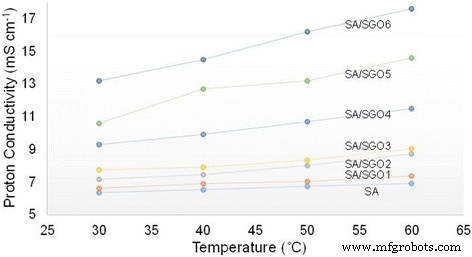
Proton conductivity of SA/SGO biomembranes with various content of SGO at different temperature
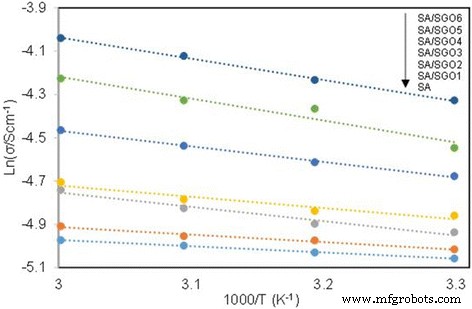
ln σ vs. 1000/T plot for the cross-linked QAPVA membranes, the lines indicate the linear regression
Figure 13a presents the suggested proton mobility mechanism in SA/SGO plasticized with glycerol in which high synchronization exists between H + and electron lone pairs belonging to the oxygen atoms carrier in glycerol and the hydrophilic sulfonic acid groups in SGO nanosheets. We believe that the proton transport applies both Grotthus and vehicle mechanisms, strengthened by the SGO particles.
The SA/SGO biomembranes show very low methanol permeability, and the lowest was achieved by SA/SGO6 (1.535 × 10 −7 厘米 2 s −1 ), as listed in Table 2. The low methanol permeability can be explained in terms of the membrane microstructure between sodium alginate, SGO, and glycerol plasticizer. The introduced SGO particles serving as fillers in the SA polymer create substantial obstacles to the linked hydrophilic passages. The SGO filler blocks the migration of methanol passing through the membrane, and this is known as the blocking effect, which reduces the methanol permeability. The methanol permeability also decreases because of the interfacial interaction between the SGO and SA biopolymer [41]. The methanol permeability of the SA/SGO6 bio membrane at four different temperature conditions is shown in Fig. 12. As seen, the methanol permeability increases at a higher temperature, which can be related to the structure changes of the bio membrane. The higher temperature provides more heat, which can shake the membrane chains and molecules, thus leading to more free volume, which consequently reduces the methanol blocking effect. Less resistance causes easier movement of methanol diffusion [59]. Mu et al. [60] reported the decrease in methanol crossover in the presence of Au nanoparticles self-assembled on a Nafion membrane, which consequently improved the overall performance.
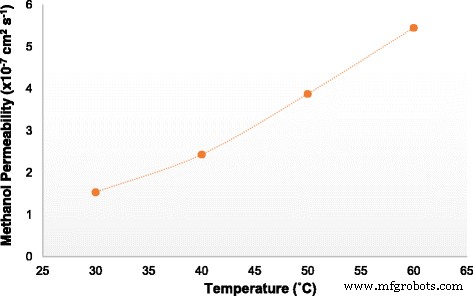
Methanol permeability of membrane SA/SGO6 vs. temperature
The interfacial interaction between SGO filler, glycerol, and SA polymer confines the hydrophilic passage formation in the membrane, and this wide hydrophilic passage is a significant factor in methanol migration [19]. Thus, the presence of SGO facilitates methanol permeability reduction [6]. The proposed mechanism of methanol rejection is presented in Fig. 13b.
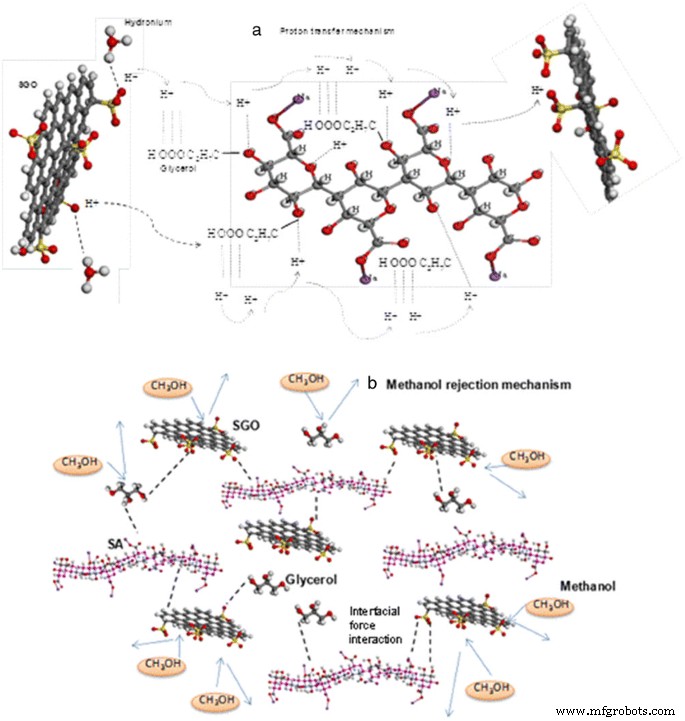
Suggested mechanism of a proton mobility and b methanol rejection
It was noticed that a higher selectivity value resulted in a higher DMFC capability. The selectivity values of the SA/SGO can be observed in Table 2, which compares the selectivity among SA and SA/SGO biomembranes as well as Nafion 117 membranes from previous work. The presence of SGO enhanced the selectivity of the SA/SGO polymer membrane (8.555 × 10 4 S s cm −3 for 0.2 wt% SGO loading), which is higher than that of SA (3.7678 × 10 4 S s cm −3 ) and fortunately also higher than that of Nafion 117 (7.99 × 10 4 S s cm −3 ) [38], 4.05 × 10 4 S s cm −3 [61], and 4.22 × 10 4 S s cm −3 [62], in which the low methanol permeability is the main factor to be considered.
Single Cell
Single-Cell Performance Evaluation
Figure 14 indicates the cell polarization result for pure alginate, SA/SGO6 composite biomembrane and Nafion 117 under ambient temperature, 4 M methanol concentration and passive mode condition. The SA/SGO6 composite biomembrane was applied due to the high selectivity factor and obviously had a higher open-circuit voltage (0.63 V), which can be related to the low methanol permeability equaling to that the sodium alginate biomembrane. The OCV of Nafion 117 (0.52 V) in the current study is lower than SA/SGO and sodium alginate, which might be due its higher methanol permeability. The crossing of methanol through the membrane leads to the reduction in the OCV value. The higher OCV of SA/SGO and alginate membrane is the big indicator that synthesized membrane has lower methanol permeability compared to Nafion, which the main objective of this study is successfully achieved. The improvement in the power density of SA/SGO6 is due to the sulfonic acid group that functions as a proton transferral pathway as well as a methanol inhibitor, thus achieving 5.9 mW cm −2 compared to the sodium alginate, which achieved only 2.83 mW cm −2 . However, Nafion 117 achieved a higher power density, which was 6.62 mW cm −2 . Thiam et al. [38] reported the performance of Nafion 117 membrane under the same condition with a power density of 7.95 mW cm −2 . No doubt, Nafion achieves a better performance in DMFC application due to the excellent proton conduction. However, the power density performance between Nafion 117 and SA/SGO biomembranes does not show a big difference quantitatively. Hence, SA/SGO can be an alternative membrane for DMFC in the future. However, the properties of the membrane still need to be enhanced, and higher wt% of SGO filler can probably be used to obtain a higher power density. To the best of our knowledge, there is only one previous work by Pasini Cabello et al. that has examined the single-cell performance in DMFC application using an alginate biopolymer-based membrane [18]. They tested an alginate/carrageenan membrane at temperatures of 50, 70, and 90 °C in 2 M methanol concentration in the active mode, which achieved maximum power densities of 10.4, 13.9, and 17.3 mW/m 2 , 分别。 The active mode has an advantage due to the continuous flow of the methanol feed into the cell that allows the reaction to occur continuously and thus is capable of achieving a higher power density. The higher power density could be achieved at a higher temperature due to the higher number of activated protons. Nevertheless, this work is an indicator that biopolymer-based membrane has a big potential that can be explored and applied in DMFC systems.
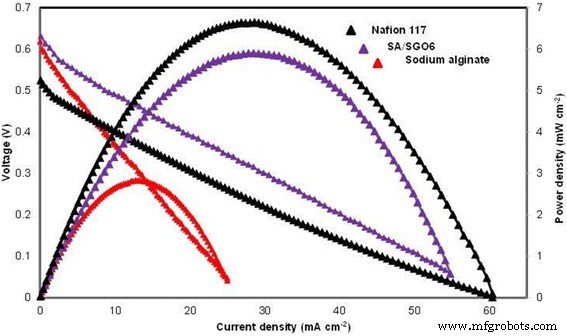
Single-cell performance test for sodium alginate, SA/SGO6, and Nafion 117 (4 M methanol and 25 °C temperature, passive mode)
结论
In conclusion, a membrane with low methanol permeability, high proton conductivity, and high selectivity was successfully prepared through the simple technique known as the blending method. The presence of sulfonated graphene oxide enhanced the properties of the alginate-based polymer membrane in terms of proton conductivity and methanol permeability. The sulfonate groups facilitated the networking between the alginate polymer and the graphene oxide filler. The blocking effect of SGO also reduced the methanol crossover in the membrane. The primary weaknesses of the alginate polymer, which are its mechanical properties of tensile strength and elongation at break, were also improved by the addition of SGO into the polymer matrix. The presence of SGO improved the SA/SGO membrane to a high level comparable to commercial membranes.
缩写
- BC:
-
Bacterial cellulose
- CNC:
-
Cellulose nanocrystal
- CNFs:
-
Cellulose nanofibers
- CNT:
-
碳纳米管
- DI:
-
Deionized
- DLFC:
-
Direct liquid fuel cell
- DMFC:
-
Direct methanol fuel cell
- EDX:
-
Energy dispersive X-ray
- FESEM:
-
Field emission scanning electron microscope
- FTIR:
-
傅里叶变换红外
- GO:
-
Graphene oxide
- GOS:
-
Graphene oxide sheet
- HRTEM:
-
高分辨透射电子显微镜
- IEC:
-
Ion exchange capacity
- L :
-
Distance between the two electrodes
- OCV:
-
Open circuit voltage
- P:
-
Membrane diffusion permeability for methanol
- PEMFC:
-
Polymer electrolyte membrane fuel cell
- PEMs:
-
Proton exchange membrane
- PMA:
-
Phospho molybdic acid
- PSSA:
-
Poly-styrene sulfonic acid
- PVA:
-
Poly vinyl alcohol
- PVP:
-
Poly (vinyl pyrrolidone)
- R :
-
Resistance of the membrane
- RGO:
-
Reduced graphene oxide
- SA:
-
Sodium alginate
- SA/SGO:
-
Sodium alginate/sulfonated graphene oxide membrane
- SGO:
-
Sulfonated graphene oxide
- SHNT:
-
Sulfonated halloysite nanotube
- SPSF:
-
Sulfonated polysulfone
- SW%:
-
Swelling ratio percentage
- T :
-
Membrane thickness
- TGA:
-
热重分析
- W :
-
Width of the membrane
- WU%:
-
Water uptake percentage
- XPS:
-
X射线光电子能谱
纳米材料
- 扬声器和耳机中的石墨烯
- 用于增强药物递送的纳米纤维和细丝
- 钛酸盐纳米管装饰氧化石墨烯纳米复合材料:制备、阻燃和光降解
- 石墨烯和氧化石墨烯的体外和体内生物安全和抗菌能力
- 通过静电纺丝法制备用于直接甲醇燃料电池的新型复合二氧化钛碳纳米纤维阳极催化剂的制备和表征
- 通过蒸发诱导自组装和增强的气敏特性简便合成虫孔状介孔氧化锡
- 通过尺寸、修饰、缺陷和掺杂设计和调整石墨烯功函数:第一性原理理论研究
- 石墨烯/WO3 和石墨烯/CeO x 结构作为超级电容器应用电极的评估
- 纳米级 CL-20/氧化石墨烯的一步球磨制备显着降低粒径和灵敏度
- 通过球形和夹心结构石墨烯/Sio2 支撑制备超高分子量聚乙烯/石墨烯纳米复合材料的原位聚合
- 单独用二氧化钛包覆二氧化硅并用海藻酸钠改性作为重金属离子吸附剂
- 氧化石墨烯的低温还原:电导率和扫描开尔文探针力显微镜


